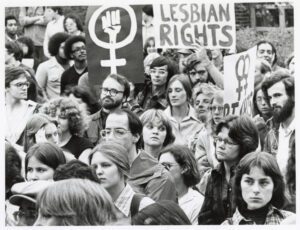Though it may not be the first state to come to mind when you think of a lesbian bar, Ohio actually has a rich history of lesbian bars. For instance, Summit Station, originally located at 2210 Summit Street, was “the largest women’s bar in Columbus” according to the 1984 and 1986 Mid America Gay Invitational Classic (MAGIC) bowling tournament programs.[1] The bar was originally named Jack’s A Go Go and briefly went by the name Logan’s Off Broadway. Patrons usually just called the bar “Jack’s” after it became a lesbian bar in 1970. In 1980, bartender and performer Petie Brown learned that the bar was up for sale. Worried about rumors that the bar would “become straight,”[2] Brown purchased Jack’s A Go Go from owners Donald and Cleta Logan and renamed it Summit Station.[3]
During its heyday in the 1980s and 1990s, Summit Station was widely popular. Several LGBTQ+ publications featured the bar, including Columbus Gay Pride Parade programs and MAGIC bowling tournament programs. Summit Station hosted several lesbian performers and drag king groups, including the H.I.S. Kings’s debut show on September 13, 1996.[4]

Signed t-shirt from Suzanne Westenhoeffer, an out lesbian comedian who lived part-time in Columbus, circa 1990s.
Summit Station also gave back to the community. For instance, the bar supported the Pacesetters, the longest-running team in the National Women’s Football League. Many of the women who played for the Pacesetters were gay. Often, players joined the team after hearing about it through word-of-mouth at Columbus lesbian bars like Summit Station.[5] Summit Station also supported the Stonewall Union (now Stonewall Columbus), an LGBTQ+ community organization and held benefits for organizations such as the Children’s Hospital, the Columbus AIDS Task Force, and CHOICES.[6]
In the early 2000s, Jack Criswell, who owned several LGBTQ+-focused businesses and produced a gay and lesbian publication called Spotlight, purchased Summit Station. In 2007, the Short North Gazette reported that Summit Station was Columbus’s “longest-standing gay and lesbian bar.”[7] Summit Station closed sometime in 2007 or 2008, after nearly forty years as a community space for LGBTQ+ patrons in Columbus. Other lesbian bars in Ohio besides Summit Station that have now shuttered include Wall Street Downtown and Blazer’s Pub. Currently, there is only one lesbian bar left in Ohio: Slammers.[8]
So, if lesbian bars were so popular in Ohio, why is only one bar still open? The closure of lesbian bars in Ohio is part of a broader national trend over the past few decades. According to NBC News, almost 200 lesbian bars across the United States have closed their doors since the 1980s. During the 1980s, the heyday of lesbian bars, there were a little over 200 bars operating in the U.S. Since then, the number has been steadily dropping. In 2020, there were only 21 bars left. Today, there may be as few as fifteen.[9]
There are multiple reasons for the slow death of lesbian bars in the United States. One important factor is a shift in how community spaces like bars label themselves. Many bars now call themselves LGBTQ+ bars rather than catering specifically to one queer identity, such as the lesbian community.[10] Another reason is the rising cost of rent and increasing gentrification of many cities in the United States. Bars struggle to pay their overhead because of high rent and supply costs. Communities that kept the bar afloat in the past can no longer afford to live in the area.[11]

This image shows four people at the Columbus Gay Pride Parade, circa 1990s. The two individuals at the left are wearing “Gay for the 90s” t-shirts.
Of course, another recent factor is the COVID-19 pandemic. Regulations intended to slow the spread of the virus hit nightlife and service industries, such as bars, particularly hard. Bars that already operate on a slim profit margin struggled to stay afloat with reduced hours and capacity. Additional waves of the COVID-19 virus caused further economic damage to lesbian bars, as customers chose to stay away from public spaces.[12]
Despite widespread closures, the queer community generally agrees that lesbian bars were both important for previous queer communities and vital to the continuation of queer nightlife. Many queer women, particularly those who identify as lesbians, argue that these bars are worth saving today. In 2020, New York filmmakers/directors Elina Street and Erica Rose produced a public service announcement titled “The Lesbian Bar Project,” narrated by Lea DeLaria. The Lesbian Bar Project intends to “celebrate, support, and preserve the remaining Lesbian Bars that exist in the United States.”[13] The initial PSA and fundraising effort in 2020 raised more than $117,000 to support these bars. On June 3, 2021, the Lesbian Bar Project team produced a twenty-minute documentary about the project. Throughout 2021 and into 2022, the project has continued to fundraise for lesbian bars across the U.S. and raise awareness about the closures of queer spaces.

Columbus Free Press photo capturing Lesbian Rights Advocates, circa 1975-1985
Though Summit Station and other lesbian bars in Ohio have closed their doors, Ohio still has one of the few remaining lesbian bars in the United States. Slammers is the last surviving lesbian bar in Ohio, and it is one of only fifteen remaining lesbian bars in the United States. Slammers opened in 1993 and is still owned by Marcia Riley.[14] Slammers was one of the bars supported by the Lesbian Bar Project in 2020 and 2021. Slammers has also adapted to the cultural labeling shift for LGBTQ+ bars. Though Riley and many patrons still define the space as a lesbian bar, manager Nikki West says that it is inclusive of many different gender identities and sexual orientations.[15]
Currently, the Gay Ohio History Initiative and the Ohio History Connection Historical Marker team is working with Julia Applegate, who performed with the H.I.S. Kings, to research and write text for a historical marker about Summit Station. Though many lesbian bars have closed, their memory lives on in Ohio through historic preservation and education efforts. New bars will create new queer community spaces, and the old bars will not be forgotten.
***
[1] MAGIC Columbus 1984 and 1986 brochures, 1984 and 1986, MSS 1669 AV, Box 1, Folder 5, Michael O’Brien Collection, Ohio History Connection, Columbus, Ohio
[2] Kim Dill, “Summit Station Still Going Strong,” Stonewall Journal, October 1997.
[3] Kim Dill, “Summit Station Still Going Strong,” Stonewall Journal, October 1997.
[4] Confessions of a Midwestern Drag King by donna jean troka, 1997-2002, MSS 1419, Box 1, H.I.S. Kings Records, Ohio History Connection, Columbus, Ohio.
[5] Britni de la Cretaz and Lyndsey D’Arcangelo, “How One Women’s Football Team Took Control Away from the Men,” Sports Illustrated, October 29, 2021
[6] Kim Dill, “Summit Station Still Going Strong,” Stonewall Journal, October 1997.
[7] Margaret Marten, “Dis ‘n’ Data,” Short North Gazette, April 2007
[8] Erica Thompson, “Pride: Last Lesbian Bar Standing,” Columbus Alive (Columbus Alive, June 12, 2019)
[9] Julie Compton, “A Year into Pandemic, America’s Remaining Lesbian Bars Are Barely Hanging On,” NBCNews.com (NBCUniversal News Group, April 4, 2021)
[10] Savannah Eadens, “It’s ‘Cheers, but Queer.’ Louisville’s Last Lesbian Bar Reflects Shift in LGBTQ Nightlife,” Journal (Courier Journal, June 28, 2019)
[11] Sarah Marloff, “The Rise and Fall of America’s Lesbian Bars,” Smithsonian.com (Smithsonian Institution, January 21, 2021)
[12] Julie Compton, “Few Lesbian Bars Remain in the U.S. Will They Survive COVID-19?,” NBCNews.com (NBCUniversal News Group, May 1, 2020)
[13] “The Lesbian Bar Project,” The Lesbian Bar Project, 2021
[14] Erica Thompson, “Pride: Last Lesbian Bar Standing,” Columbus Alive (Columbus Alive, June 12, 2019)
[15] Erica Thompson, “Pride: Last Lesbian Bar Standing,” Columbus Alive (Columbus Alive, June 12, 2019)